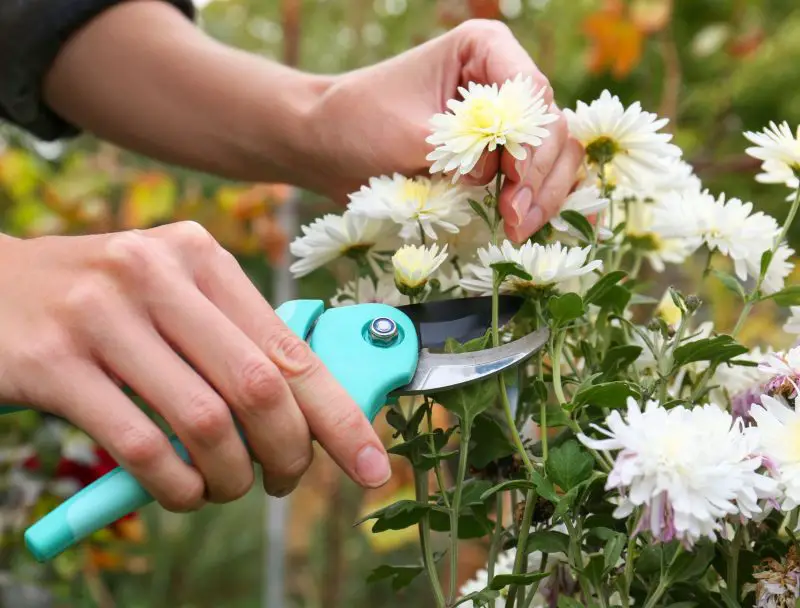Chrysanthemums, often lovingly referred to as mums, are one of the most beloved fall-blooming perennials. Their vibrant colors and full blooms create spectacular displays in gardens, containers, and borders during late summer and fall. However, as the season progresses, spent flowers can make even the healthiest plant appear tired and untidy. Understanding how to deadhead mums the right way can significantly extend their blooming period, keeping your garden lively and fresh for weeks longer.
Deadheading is a simple horticultural technique that involves removing faded or dying flowers. It helps redirect the plant’s energy from seed production back into foliage and flower development. When done properly, this process not only improves the overall appearance of your mums but also encourages them to produce more blooms throughout the season. In this comprehensive guide, you’ll discover why deadheading is important, when to do it, and how to perform it effectively to keep your mums at their best.
Why Deadheading Mums Makes a Big Difference

Mums are naturally prolific bloomers, but like most flowering plants, their energy shifts once flowers begin to fade. If dead flowers are left on the plant, it signals the end of the reproductive cycle, leading to seed formation. As a result, the plant reduces its focus on new blooms and begins to wind down. Deadheading interrupts this process by removing those signals, encouraging the plant to keep producing new flower buds instead.
In addition to prolonging bloom time, deadheading mums improves their overall appearance. Spent blooms tend to turn brown and shrivel, making even a healthy plant look neglected. By removing these unsightly remains, you instantly refresh the plant’s look and create space for new blooms to thrive. A consistently deadheaded mum plant will maintain its vibrant, full-bodied display throughout the season, maximizing its ornamental value.
Another important reason to deadhead is disease prevention. Dying flowers can harbor mold or mildew, especially during damp autumn weather. Allowing these blooms to remain may increase the risk of fungal infections or attract unwanted pests. By keeping the plant clean and tidy through deadheading, you promote better airflow and reduce potential health problems.
Understanding the Growth Habit of Mums
Before diving into the deadheading process, it’s helpful to understand how mums grow. Mums are herbaceous perennials, meaning their top growth dies back in winter while the roots persist underground. They produce bushy growth with multiple stems that each support several flower buds. Most garden mums are classified as either garden hardy mums or florist mums, depending on their hardiness and breeding.
The flowers of mums typically open in clusters and bloom for several weeks. Once the central flowers in a cluster begin to fade, the surrounding buds may still be developing. It’s important to observe the blooming pattern carefully to avoid removing healthy buds when deadheading. By watching how your mums flower and fade, you’ll gain a better sense of timing and technique for maintenance.
Mums are also photoperiodic, meaning their blooming is triggered by the length of daylight. This natural rhythm affects how long they continue to bloom after deadheading. While you can’t change the season, you can certainly influence the plant’s energy distribution by removing spent flowers consistently.
When to Start Deadheading Your Mums
Timing is crucial when it comes to deadheading mums. The best time to start is as soon as the first set of blooms begins to show signs of fading. Typically, the petals will begin to curl inward, discolor, or dry out. At this stage, the plant is still producing new buds, and removing spent flowers will quickly encourage the next round of blooms to open.
Deadheading should be performed regularly throughout the blooming season, usually from late summer into early fall. Checking your mums every few days during their peak bloom period allows you to catch fading flowers before they begin to decay. The earlier you remove spent blooms, the faster the plant can redirect its energy.
Avoid waiting until a large portion of the plant has faded. Deadheading is most effective when it is part of your ongoing garden maintenance routine. A few minutes spent each week can make a dramatic difference in the longevity and vibrancy of your mum display.
How to Identify Spent Blooms
Recognizing which flowers need to be deadheaded can be tricky at first, especially since mums bloom in tight clusters. A spent bloom will usually appear duller in color compared to fresh ones. The petals may be wilted, brown at the tips, or curling inward. Often, the flower head begins to droop or look compacted as it dries out.
Healthy buds, on the other hand, are firm and upright. They may still be tightly closed or partially open with vibrant coloration and smooth petals. It’s important to distinguish between blooms that are fading and those that are still developing. Accidentally removing new buds will reduce your plant’s blooming potential.
Another sign to watch for is seed formation. If the center of the flower begins to swell or harden, it’s an indication that the plant is shifting its focus toward seed production. Removing these early helps prevent the diversion of energy away from new blooms.
How to Deadhead Mums Correctly
To deadhead mums effectively, you’ll need to remove the entire spent flower head, not just the petals. This means cutting the stem just above the next healthy set of leaves or buds. Using clean, sharp pruning shears or scissors ensures a precise cut and reduces the risk of disease.
Gently hold the stem with one hand and snip just above the leaf junction with the other. If multiple blooms are clustered together, assess each one individually and remove only those that are fading. For mums in dense clusters, you may need to carefully part the foliage to reach spent flowers without damaging surrounding growth.
In cases where the entire stem has finished blooming, you can remove the whole stalk down to the main stem or base. This tidies up the plant and allows new shoots to receive light and air. Always sterilize your tools between cuts if you’re dealing with multiple plants to prevent spreading disease.
What to Do with the Removed Blooms
Once you’ve deadheaded your mums, don’t just leave the clippings on the soil surface. Spent blooms left on the ground can attract pests, promote mold, or contribute to fungal infections. Collect the removed flowers and compost them if they’re free of disease. Otherwise, dispose of them in your yard waste bin.
Composting is a great way to return nutrients to your garden, especially if your mums were grown organically. Just ensure your compost pile reaches sufficient temperatures to break down any pathogens that may be present in the blooms. This step supports sustainable gardening and keeps your landscape clean.
For gardeners who enjoy creative reuse, dried mum blooms can also be incorporated into decorative wreaths or dried flower crafts. Although they won’t retain their full color, they can add texture and interest when preserved properly.
How Often Should You Deadhead Mums
The frequency of deadheading depends on how quickly your mums bloom and fade. During peak blooming, you may find yourself deadheading every few days. A quick walk through the garden to inspect your mums can help you stay ahead of declining blooms and catch them at the optimal stage.
As the weather cools and the days shorten, your mums will naturally slow their blooming cycle. At this stage, deadheading can be reduced to once a week or as needed. The key is to stay observant and responsive. Mums are generous bloomers if cared for attentively.
Inconsistent deadheading won’t kill your mums, but it will limit their blooming potential. By making deadheading a routine task during the flowering season, you’ll enjoy a longer-lasting, more vibrant display from late summer through fall.
Special Tips for Potted Mums
Potted mums, often purchased from garden centers in full bloom, can also benefit significantly from deadheading. These container plants are sometimes treated as seasonal decorations, but with proper care, they can thrive and even return next season. Removing spent blooms from potted mums keeps them looking fresh and extends their decorative appeal.
When deadheading potted mums, the same principles apply. Use clean shears to snip off faded blooms and inspect the soil and foliage for any signs of disease. Because containers dry out faster, also pay attention to watering and fertilization. A healthy, well-nourished mum is more likely to respond with new blooms after deadheading.
Position your potted mums where they receive at least six hours of sun per day. This ensures strong photosynthesis and flower development. Deadheading alone won’t compensate for poor growing conditions, but combined with proper care, it greatly enhances bloom performance.
What Happens If You Don’t Deadhead
If you choose not to deadhead your mums, they will still bloom for a time, but their performance will decline more quickly. Once the first wave of flowers fades, the plant will gradually shift toward seed production and dormancy. The remaining flowers may appear sparse, and the plant overall may lose its shape and fullness.
In addition to reduced blooming, a mum that isn’t deadheaded can look messy or unkempt. The brown, shriveled blooms detract from the fresh appearance of the remaining flowers. Moreover, the longer you wait to remove them, the more effort it takes to clean up the plant later.
While not strictly necessary, deadheading is one of the most effective and simple ways to boost your mums’ visual appeal and blooming potential. If your goal is a stunning fall display that lasts for weeks, this small step goes a long way.
Preparing Mums for the End of the Season
As autumn progresses and temperatures begin to drop, mums eventually stop blooming regardless of deadheading. At this point, it’s time to begin transitioning them into winter care. Allow the last flush of flowers to fade naturally and stop deadheading as the plant prepares for dormancy.
You can trim back mums after the first frost kills the top growth, or wait until early spring if you prefer to leave the stems as winter protection. Adding a layer of mulch around the base can help insulate the roots in colder climates. If you’re in USDA zones 5–9, most garden mums will return the following year with proper care.
Deadheading is just one part of a broader maintenance plan, but it’s a crucial one during the blooming season. Knowing how and when to do it keeps your mums healthier and more beautiful year after year.
FAQ about How to Deadhead Mums
What tools should I use to deadhead mums?
Use sharp, clean garden scissors or pruning shears. This prevents tearing stems and minimizes disease risk.
Can I deadhead mums with my fingers?
Yes, you can pinch off faded blooms by hand if the stems are soft. However, scissors give more precise results and reduce plant damage.
Will mums bloom again after deadheading?
Yes, mums often produce more buds if deadheaded early in the bloom cycle. This helps extend the flowering period.
Is deadheading necessary for all types of mums?
Most garden mums benefit from deadheading, especially those grown for ornamental purposes. Florist mums may bloom once and not rebloom even with deadheading.
Should I stop deadheading at some point?
Yes, stop deadheading when the blooming period naturally ends in late fall or when frost kills the flowers.
Conclusion
Deadheading mums the right way is a simple yet powerful technique to keep your plants blooming longer and looking their best. By removing faded flowers promptly, you help redirect energy into fresh growth, prevent disease, and maintain a tidy garden display. With regular care and attention, your mums will reward you with vibrant, long-lasting blooms that brighten your landscape throughout the fall season.






